The Excursion Into Semyonov.
 Boris
Kornilov square.
Boris
Kornilov square.
This square is named after a famous
poet, our countryman Boris Petrovich Kornilov, who sang the praises of his
motherland-Nizhegorodskaya region. «The nightingale of Semyonov» that is how
people call him with respect. Now Boris
Kornilov is famous all over the Russia. In 1992 Engels square changed its name
into Boris Kornilov square to immortalize the name and the memory of the poet.
Boris Kornilov was born in Semyonov in 1907, he spent his childhood and youth
here, in Semyonov he began to create his poems. The pick of his creative work
was in the 1930-s, that was an extremely hard Soviet period that hurt the young
poet soon. When Boris Kornilov was a beginner another poet Sergey Esenin had
practically finished his way. Esenin died .The two poets had much in common
because they both were born and grew up in the country. And we can say that
Sergey Esenin passed the baton to Kornilov. The life of the poet was finished
tragically, Boris Kornilov was killed when he was in his thirties. Because of
the repressions Stalin pursued Boris Kornilov was shut down in 1938 in
Levashovskaya pustosh (Leningrad region). The talented poet left for us not
numerous but really a priceless inheritance: some poems about the Civil War and
about 200 lyric poems. That was all he had written during the 10 years of his
life he dedicated to Literature. And we are thankful together for his marvelous
poems and we keep the memory of him in our hearts. And now we can say that his
words came to life:
|
|
"You
will never be gone, my pine,
My adoring land.
Some
time I will sow the seeds again.
Ты не уйдешь, моя сосновая,
Моя
любимая страна.
Когда-нибудь, но буду снова я,
бросать
на землю семена "
|
|
In the picture we can see the
monument to Kornilov and the school where the poet studied in 1920-1923/4. The school
is rather an old building. It was built in 1898. And in 1998 the secondary
school №1, that is situated here now, celebrated its 100 Anniversary. The first
building was wooden and 1-stored. Then a new one was made of red brick; it is
now a part of the school.
 A famous artist of Russian Federation Anatoliy Bichukov, who
adores the poetic works of Boris Kornilov, made the monument to Kornilov from
pink granite. The monument was built in 1967, it was open in 1968, and in 1987
it was replaced to Kornilov square. Every year on Boris Kornilov`s birthday
those who esteem his poems come to the monument and bring flowers.
A famous artist of Russian Federation Anatoliy Bichukov, who
adores the poetic works of Boris Kornilov, made the monument to Kornilov from
pink granite. The monument was built in 1967, it was open in 1968, and in 1987
it was replaced to Kornilov square. Every year on Boris Kornilov`s birthday
those who esteem his poems come to the monument and bring flowers.
Let’s go back to the square, to its plan. For
the building of Semyonov the general plan was confirmed. генеральный планThat
was an ideal square with 5 squares within: Sobornaya, Schepnaya, Lozhkarnaya, Nizhnyaya
Bazarnaya and Verkhnyaya Bazarnaya. Now we are in former Verkhnyaya Bazarnaya
square, from which 6 streets run like the rays: to the right of the school
there is Pionerskaya str. (former Verkhniy lane, later B.Kun str.), then there
is Fevralskoy Revolyutsii str. (former Dyakovskaya str.), to the right of it
there are small streets: Galanina str. (former Malaya Gildeyskaya str.),
Krasnoarmeyskaya str. (former Bolshaya Gildeyskaya str.), Vaneyeva str. where
Semyonov Museum of History and Art is located. To the right of this street
there is Respublicka Sovyetov str.
We would like to pay your attention to
the house that is located at the corner of Fevralskoy Revolyutsii str. It is an
old house over 100 years old. Since 1879 its owner was Ivan Kirillovich
Kiselyov. There were a greengrocery and a spoon-engraver’s workshop with 4
workers in the house. Kiselyov also had got a small shop in Schepnoy Row of
Nizhegorodskaya Yarmarka, his son Peter and his daughter-in-law Alexandra
Semionovna mostly were there. The Kiselyovs got on well with Agraphena Osipovna
Vitushkina who was the nurse of their son Yuriy. When Soviet Authority came the
Kiselyovs were living in Krayushkina str., but then they left for Nizhniy
Novgorod. Either did Vitushkina in the 1920-s. During the repressions the
Kiselyovs were arrested. But they had given Vitushkina a sack with their jewels
to keep. The authorities tried to make the Kiselyovs give up all the precious,
and the Kiselyovs asked Agraphena Vitushkina to give up their jewels to save
her and their son’s lives. Vitushkina did not even know what was in the sack.
After they had been released from the prison the Kiselyovs moved to Saratov.
Yuriy Petrovich Kiselyov became an actor and then the Head Director of Saratov
Theatre Of A Young Spectator. He was honored the name of the Public Actor of
USSR. Kiselyov died in 1997.
And we are going on our excursion. The small
green street, we are in now, is named after a famous revolutionary Anatoliy
Vaneyev who was Lenin’s compare in arms. His family lived in our town, Vaneyev
studied here in 1880-1882.
The former name of Vaneyeva str. is Kommunar str. There are different houses in
this street: there you can see either the houses built in our days or the old
houses which give you a real pleasure to look at. In the streets of our town
there are many houses decorated with beautiful wooden lace.
House №12 is connected with the name of Boris
Kornilov, there is a memorial plank on the wall of the house. The family of the
poet lived here in 1922-1923. Until 1922 the Kornilovs had been living in
Dyakovo (a small village not far from Semyonov), then they left for Vaneyeva
str. and had been living here for half a year, then they moved to Krestyanskaya
str. (now Kornilov str.). This house is very old, it is about 100. Merchant Sergeyev who sold spoons was its
owner.
Well, now let’s pay our attention to the house № 10. It is the oldest house in
the street. It was built by Peter Sharyghin. The house is about 150 years old
and its architecture is typical for the middle of the XIX century: it is
wooden, has 5 windows and has the form of a stretched rectangle. His owner was
an old-believer and we can see rather a simple, but very solid house that looks
like a monument to the provincial culture.
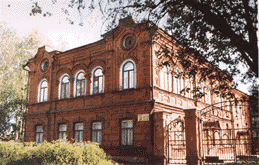 About 100 years ago Peter Sharygin`s son, Pyotr Petrovich, who was
a merchant, built a nice 2-stored red brick house in Slastyoninskaya str. Pyotr
Petrovich bought spoons. He had some workshops where the workers painted the
spoons. When spring came Pyotr Sharygin himself brought the spoons to
Nizhegorodskaya Yarmarka, sold them for a much more expensive price, than he
paid his workers for their work, and that is how he earned a lot of money for
himself and for his family. He was very greedy. Going to the Yarmarka he always
walked all the way on foot to put more product on the cart. He was eager to
have a large family, that is why he had built such a big house. But he was
punished by the cruel fate: his babies died. Only his daughter Anna survived.
There is an old building near the house. It was the Sharygins` store-room. It
was built in 1902. People say once a lot lf gold was stolen from that
store-room. But panic did not seize Pyotr Petrovich. He did not even go to
police. We can not say what was the reason his having behaved like this. Either
he was very rich or being a real old-believer he did not wear his heart out of
his sleeve. When the revolution came he was still alive and was got out of his
house by the authorities. But he was allowed to look after the house. He died
in 1920 when he was 75 years old: he wanted to clean the roof of his house from
the snow, but fell down and died.
About 100 years ago Peter Sharygin`s son, Pyotr Petrovich, who was
a merchant, built a nice 2-stored red brick house in Slastyoninskaya str. Pyotr
Petrovich bought spoons. He had some workshops where the workers painted the
spoons. When spring came Pyotr Sharygin himself brought the spoons to
Nizhegorodskaya Yarmarka, sold them for a much more expensive price, than he
paid his workers for their work, and that is how he earned a lot of money for
himself and for his family. He was very greedy. Going to the Yarmarka he always
walked all the way on foot to put more product on the cart. He was eager to
have a large family, that is why he had built such a big house. But he was
punished by the cruel fate: his babies died. Only his daughter Anna survived.
There is an old building near the house. It was the Sharygins` store-room. It
was built in 1902. People say once a lot lf gold was stolen from that
store-room. But panic did not seize Pyotr Petrovich. He did not even go to
police. We can not say what was the reason his having behaved like this. Either
he was very rich or being a real old-believer he did not wear his heart out of
his sleeve. When the revolution came he was still alive and was got out of his
house by the authorities. But he was allowed to look after the house. He died
in 1920 when he was 75 years old: he wanted to clean the roof of his house from
the snow, but fell down and died.
After
the revolution that house was occupied by different organizations: a boarding
house for orphans, a military house, a policlinics, the region committee of
Comsomol, etc. In 1920-s there was the Communists` Club where Boris Kornilov
worked after having finished the school. There were some pioneer groups under
his leadership. Young people acted in different role-plays, Boris Kornilov himself
brought out a Comsomol newspaper for the youth. It is here where Boris Kornilov
began to create his first poems. They were published in the satirical magazine
«Lozhkoi Po Lbu» and in the newspaper «Komsa». Boris Kornilov was noticed by a
man of letters Pavel Shtatnov who wrote articles for the newspaper «Molodaya
Rat» (now «Leninskaya Smena»), and Shtatnov helped Kornilov to become a serious
poet.
In
the beginning of Vaneyeva str. there are two buildings built in the second part
of the XIX century. In the 1-stored house there was the church school for poor
boys that gave a 3-form education. The resources for the constructing of the
school were given by the Government of the town. Near this house there was a
school for girls, after graduating from the school they could enter to a
gymnasia for women. There was also the Committee of the school with Nickolay
Florinskiy as the headmaster.
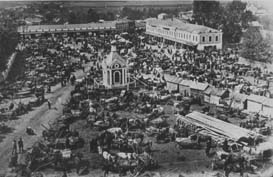 Former Sobornaya square, 1914.
Former Sobornaya square, 1914.
And we are going on our excursion.
We are in V.I.Lenin square (former Sobornaya square). It is the centre of our
town. Earlier there was the boundary of Semyonov, next to the boundary there
were deep forests. Before Semyonov became a town a small village on the river
Sanakhta had appeared there on the verge of 17-18 centuries. The houses were
built near the very river, and the first street got the name Sanakhtinskaya
(now Volodarskogo str.).
In 1717 the first church was built near
Bazarnaya square, the church was located behind the shop, which is called «Utro».
Behind the church up to the mini-market there was a cemetery. That church had
been standing there for nearly 60 years. But in 1779 a fire happened and the
church was burnt. But soon it was reconstructed. Three years later, when the
square became wider, the location of the church was changed. It was replaced
out of the town, and was located a bit behind the church that we can
see now in Gagarina str. (former Semyonovskaya). In 1779 by the decree of
Ekaterina II the village of Semyonov was named a town, and from that moment it
was being constructed strictly according to the plan that had been worked out
by the architect Fyodor Guinneh. In that plan we can see the classical French
principals of construction: strait, wide, ray-like streets that run to the
square. The town is planned as a rectangle, which is broken out by numerous
crossing streets into 16 smaller quadrates crossed by two diagonal streets. At
the place of their cross the central square, we are in now, is located. From
this square 6 streets stretch. And at the corners of the rectangle there are 4
more squares. One of them, Boris Kornilov square, we have been to. The main
quantity of the buildings in Semyonov was constructed from the beginning to the
middle of 1840-s. The first general plan of Semyonov is now the base for the
planning of the town not only in the centre, but also in the new districts and
on the outskirts either. Semyonov is now registered as a monument of
architecture, and is on the list of the historical places of Russia. The
central building of Sobornaya square was Voznesenskiy Cathedral, that does not
exist now. There is the local House of Culture at the place of its former
location. The Cathedral was built in 1819 and was over 100 years old. In the
old photos we can see that it was really beautiful and rich. The bricks for the
construction of the Cathedral were brought from different places of the
country, and then a pit was dug near the place of construction. There clay was
found. The bricks were made from that clay. Later this pit began to fill in
with water. And a small pond appeared. It was named the Soborniy pond that we
can now see behind the House of Culture.
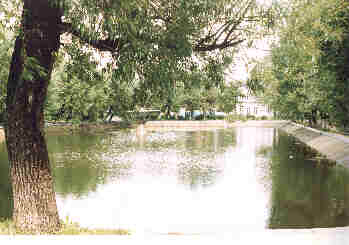 The Soborniy pond, 1998.
The Soborniy pond, 1998.
Voznesenskiy собор was sacred in 1821 and was visited
by the huge quantity of the inhabitants of the town and the nearly located
villages (from Diakovo, Zhuzhelka, Khvostikovo, Deyanovo, Sodomovo, etc.). To
that Cathedral Rozhdestvenskaya Church (that was built in 1819) and Vsekh
Svyatskaya Church (that was built in 1853 and exists now) were ascribed. Всех святская церковь Now
we do not know the names of the first priests, but later they were:
Bogomolskiy, Rozhdestvenskiy, Milotvorskiuy, Pavel Lebedev, who lived near the
Cathedral (there the company of telephone communications «Volgatelecom» and the
telegraph are now).
The Chapel made from the red brick was of the same age with the Cathedral, it
was located to the left of it. It was intended to collect the contributions.
Every evening a man came to the Chapel unlocked the door and took out the
contributions that had been given for the day.
Now we practically can not see the old
buildings on Sobornaya square, but there were a lot of: state houses, the
houses of the rich, trade rows. In the second part of ХIХ century the head of the town was G. Rekshinskiy. The houses were mostly
made of brick and the trade rows were built on both sides of the square.
Instead of the shops «Utro» and №15 there were the shops owned by Krayushkin
Nestor Vasilyevich, Savinov Efim Pavlovich, Sokolovskiy, etc. Instead of the
hotel, the tax service and the passport-visa service there was a 2-stored brick
building. On the first floor there were trade rows, on the second floor there
was the Government of the town where «the Fathers of the town» were. G.
Rekshinskiy did much good for the town. Brick houses were built, the square was
paved with cobble-stone and the first ten street lamps were lighted up. The
large clock was placed to Voznesenskiy
Cathedral. By the decree of Rekshinskiy the first fire service was created on
the territory of the square in 1874. There always was a man on duty who was to
look over the town from the tower if there were a fire anywhere.
There
is the main street in our town. It was called Pokrovka. Now its name is Lenina
str. Earlier it also had got other names: Bazarnaya str., 25 Anniversary of
VLKSM and etc. There were mostly solid stone and brick sometimes 2-stored
houses in that street. There were shops, cobble-stone paved roadway in
Pokrovka.
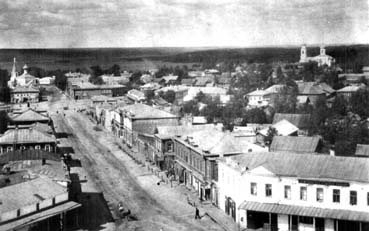 The main street of Semyonov, 1900.
The main street of Semyonov, 1900.
Many buildings of the last century
still exist now. The headmaster of the Police owned the house in the beginning
of Bazarnaya str (there is the shop of dairy products here now). There was the
Police Government in the 1-stored annex.
Opposite this house there is a 2-stored building made of brick (there is a
drug-store now). It belonged to Kulnev, a merchant. Earlier there was a
billiard room, then a library. In December 1917 there was an initiative group
of the organization of the Soviet Authority and a Revolution Committee.
Nevertheless Pokrovka is rather a short
street it has always been the main street of the town. Practically all the
houses belonged to merchants. Here is for example the 2-stored house made of
red brick. It belonged to Ivan Alexandrovich Khanykin, a merchant. There are
two letters on the wall of the house «Х» and «И», they are the initials of the owner.
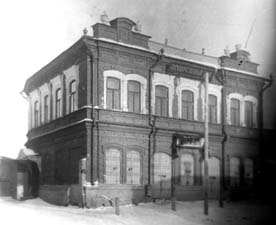 Ivan Khanygin`s house, 1920.
Ivan Khanygin`s house, 1920.
Khanygin sold cloths. He went to
Nizhniy Novgorod for the ware himself.
He with his family lived on the 2nd floor. There is the Military
Commissariat now. Down the street
there are the hoses of Ostroumov Alexander Ivanovich (shops «Pokrovka» and
«Kristall» now), and of Ostroumov Ivan Alexandrovich (shop «Gastronom»). Ivan
Alexandrovich and his brother Mikhail Alexandrovich also had got two houses in
Sergiyevskaya str. (Kirova str.). The houses were pulled down, there is the
company of telephone communications «Volgatelecom».
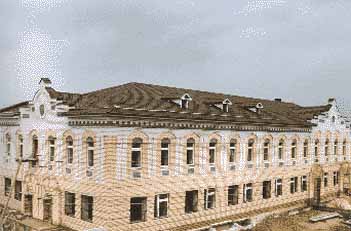 The
construction of the office of «Volgatelecom».
The
construction of the office of «Volgatelecom».
Mikhail Alexandrovich Ostroumov and his wife
Ekaterina Lukoyanovna had become parents! Their daughter was born on the 5 of
July in1884. They called her Taisia. The girl became a teacher, got married
with another teacher Pyotr Tarasovich Kornilov. In July 1907 she gave birth to
a baby-boy. He got the name Boris. Boris Petrovich Kornilov, a famous Russian
poet, who has glorified his small motherland Semyonov in his lyrical poems.
Other
buildings in Pokrovka either belonged to the merchants: Kiselyov, Smirnov,
Vitushkin, Ivanov, Startsev, Morozov, Shlyapnikov, Zuyev, Khilov. Now let’s
cross the square. So, we are in Lenin str. This part of the street is shorter
than the previous one. There are very nice old buildings in the end of it. To
the right of the road at the corner we can see a 2- stored house made of red
brick. It belonged to Vitushkin. If we look at it attentively we shall notice
that the house has very much alike with Sharygyn`s house (the museum) and the
house of the Licey. These houses were built by the same masters. To the left of
the road there is the old-believe Church. People also call it Nosovskaya, and
its official name is Nickolskaya.
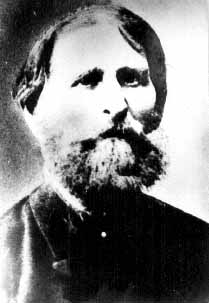 Aphanasiy Pavlovich Nosov.
Aphanasiy Pavlovich Nosov.
Aphanasiy
Pavlovich Nosov in 1874 had a 2-stored brick house that cost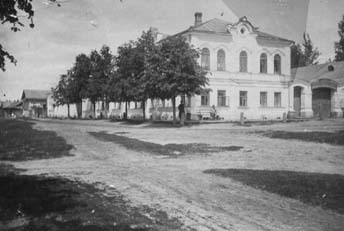 1000 roubles and his capital
consisted of 15.000 roubles. He was a businessman like his father. He bought
spoons and was a merchant. The workshops were situated in 4 rooms of their
house. 14 workers worked there. There was a store-room in two rooms of the
house. And there was a shop in one room. In 1890-1895 Nosov had got three shops
in Nizheorodskaya Yarmarka. They were situated on the seven hills -
Sankt-Peterburgskaya str. (Strelka). When the Soviet Authority came the Nosovs`
houses were requisitioned.
1000 roubles and his capital
consisted of 15.000 roubles. He was a businessman like his father. He bought
spoons and was a merchant. The workshops were situated in 4 rooms of their
house. 14 workers worked there. There was a store-room in two rooms of the
house. And there was a shop in one room. In 1890-1895 Nosov had got three shops
in Nizheorodskaya Yarmarka. They were situated on the seven hills -
Sankt-Peterburgskaya str. (Strelka). When the Soviet Authority came the Nosovs`
houses were requisitioned.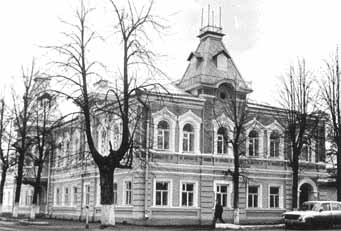
The building of the Municipality
Centre after the restoration, 1995.
After
that there was a Military Committee, an Executive Committee, a hospital, and there
is the Municipal Centre now. Now either the house with the grounds or the
church are considered to be the monuments of Architecture and are guarded by
the State. Semyonov and the villages of Semyonov district have always been the
centre of the old-believe Christianity. Before the Revolution came the
old-believers had been 1/3 of the entire inhabitants of Semyonov district.
Aphanasiy Pavlovich Nosov was a person of great respect among the
old-believers. In 1896 a pray house was open with his help. It was located in
the house of petty-bourgeois Agaphia Mikhailovna Rybina. In 1897 Rybina got the
right to built a brick house behind her 2-stored wooden one. In 1905 after the
freedom of religion had been given to people the old-believers of Semyonov
district began to construct their church under the leadership and with
financial support of Nosov. Nosov`s son Ferapont was to go to the villages to
collect the signatures for the construction of the church. Soon the church made
of red brick became the real decoration of one of the crossroads (the corners
of Pokrovka and Volodarskogo str.). красавица церковь
Aphanasiy Nosov was not able to finish
the construction of the church, he died on the 5th of April in 1912.
The corpse was buried in the vault made in one of the walls of the church.
After her husband had died Nosov`s second wife Anastasia Konstantinovna by name
left all the property she inherited and became a nun of Sharpanskiy cloister
(according to the rules she changed her name and became Alevtina). She took
only cupboards with her. Why? May be as the recollection of her adoring husband
and all the time she had lived with him. And before her departure Nosova had
given the Government 3000 roubles to construct the water pipe in the town.
Anastasia Konstantinovna died because of a strange disease of her right arm.
She did not consult a doctor: that was a sin. She was buried at Sharpanskoye
cemetery. Ten ears later after the revolution the old-believers were prohibited
to ring the bells of their church (they were told that the bells disturbs the
workers of the telegraph). In 1932 the priest of the church Alexaner Belskiy by
name died. But the church continued to work; Father Ioann became the new priest
of the church. In 1938 he was arrested by the Public Committee of Inner Affairs
(НКВД) and the church
was closed. In the beginning of the 40-s the Artillerists` Courses (АКУКС) came to the town, and the store-room
of drawing paper was located in the church. Once the people were told that the
body of Aphanasiy Nosov is going to be thrown out of the church. Yakov
Semyonovich Kaplin and Oganya Pronina (the inhabitants of the town) went to
look at that. The ashes as people
say were buried at the old-believers` cemetery that was situated in the
territory of contemporary Shkolnaya str.
The burial vault still exists now on the territory of Nickolskaya Church
it is covered with planks. In the end of the 80-s the old-believers began to
ask the authorities to give them the church back. In 1989 they got the keys.
People still remember Aphanasiy Nosov. In the church they pray for Aphanasiy
and Alevtina. Nosov bought a nearby 1-stored house for the priest of Nikolskaya
Church that had belonged to Vasiliy Maximovich Semenkov and his son Fyodor who
drew icons.Комаровский скит. There are a lot of legends about the Nosovs.
One of them is that there was an underground way that connected the Nosovs`
house and Nickolskaya church, people say that before the revolution Nosov had
concealed the treasures in that way. Of cause it is practically impossible now
to guess this mystery. May be the main treasure of the Nosovs was the way they
lived their lives, their moral quantities. The works of Ioann Zlatoust (IV
century before Christmas) were very popular with the old-believers. He said
that labor and economics are the ways to fight against poverty and as a way of
salvation of the soul. Zlatoust and all the old-believers condemned public
spectacles, sparing of the time, gluttony, shaving, hard drinking, smoking,
adultery. The main trait of the
character of an old-believer was the responsibility for his deeds and for the
deeds of his ancestors. But sometimes the exceptions took place. Aphanasiy
Nosov`s son Nikifor (the son of his first wife) ruined himself by drink and was
deprived of the inheritance and was expulsed from the merchants together with
his family in 1912. It must have been because of their responsibility that the
greatest merchants were old-believers: Savva Morozov, Mamontov, Ryabushinskiy,
Bugrov, Sirotkin, Sharygin, and Nosov.
Площадь Октябрьской революции
/Н.Базарная/
The monument to the three communists
was constructed to the 200 Anniversary of Semyonov in 1979.
...1919. The Soviet Authority makes its first
steps. The dense Kerzhenets forests cover the white guards. The Local Party
Organization does much to defeat the gang. Communists Ivan Kozlov, Anatoliy
Delfontsev, Nikandr Zavyalov go to the forests as scouts. But die caught by the
cruel enemy. And today the three Communists made of metal are the symbol of the
fight for the Soviet Authority in the district. The talented sculptors Anatoliy
Bichukov and Ivan Arefyev are the authors of the monument.
The brick trade rows are the witnesses of the life of the town before the
Revolution. They were built in the end of the XIXth century and in the
beginning of the ХХth
century. The road to them was paved with cobble-stone. Instead of the
contemporary minimarket there was the public building where different goods
were sold. The only shop in Semyonov where icons were sold was there either. It
belonged to Vasiliy Maximovich Semenkov and his son Fyodor Vasilyevich. After
the Revolution Fyodor Vasilyevich worked in the iron-hardware shop that
belonged to the corporation and was located on the corner of Nizhnyaya
Bazarnaya squ. and Nizhnyaya Bazarnaya (Lenina) str. In the building where the baker’s
shop is Savinov`s shops and store-houses were situated. Savinov himself lived
in Novoslobodskaya (Telmana) str. house 9. On the left side of the square we
can see the building of the Committee of Protection of the Nature. That
building has its own history. Before the Revolution there were trade rows.
Nikolay Mikhailovich Khekhnyov had got a shop there. He sold meat and sausages.
After the Revolution there were a hardware shop and a baker’s, inside the yard
there were shops were meat was sold. A citizen of Semyonov Dumina Maria
Mikhailovna baked bunnies herself and sold them on Nizhnyaya Bazarnaya square.
In 1932 the building began to belong to the school of artistic cultivation of
wood that played a huge role in the development of artistic trades of
Semyonovskiy region. In the 30-s the school became a centre of preparing the
basic personnel for industrial cooperation. The skilled workmen of Khokhloma
painting, turners, joiners, engravers, etc. graduated from that school. Besides
workshops and studious there was a subsidiary farm with pigs, cows, horses,
etc. In 1936-40 about 100 pupils graduated from the school every year. During
the War there were artillerists` courses in the building of the professional
school. In 1970-s 200 peoples graduated from the school every year. There were
6 classrooms, workshops, a gymnasium, a library and a hostel for 260 persons.
The goods the school made up were noticed at the international exhibitions in
Moscow and Brussels. In 1985 the new building of the professional school was
open in Chernyshevskogo str. Today the school is called the Art Licey №30. In
1934 a museum was organized in the school. The headmaster of the museum was
G.P.Matveyev. There were 1500 exhibits. In 1937 the museum was given its own
building that had belonged to Zherdinskiy (a judge). On the 1st of
January in 1935 it was opened officially. The museum was open only on Saturday
and Sunday. On weekdays the students of the professional school studied there
In 1976 the museum became a filial of Gorky Museum of History and Architecture,
and it became famous all over our country and abroad. Since 1991 the priceless
exhibits of the museum are laid out in the building of the Museum of History
And Art in Vaneyeva str.историко-художественный
музей
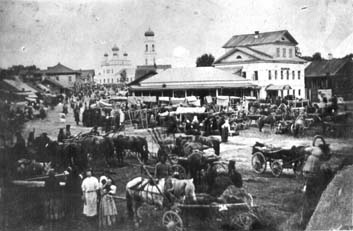 Nizhnyaya squ., the beginning of XX c.
Nizhnyaya squ., the beginning of XX c.
Before the Revolution Nizhnyaya Bazarnaya
squ. was very popular. Besides dairy products, fish and meat there was the
place called «the women market». In May and June there were the rows of young
women and girls being sold by their husbands and fathers for a season. The poor
burdened with their large families had to sell their wives and children not to
die from hunger, because they were not able to earn for their large families`
living. One of the streets crossing Oktyabrskoy Revolyutsii squ. is Telmana
str. (former Novoslobodskaya). To the right there was the house that belonged
to Antonova Maria Mikhailovna. After the War her two sister s Klavdiya
Mikhailovna Kononova and Taisia Mikhailovna Kornilova (the mother of Boris
Kornilov) lived with her. In 1948 Taisia Mikhailovna was given a land to build
a house in Uchitelskaya str., and in 1951 she moved there with her sister.
Now
we are in 1 Maya str. Before the Revolution rich people lived in this street.
To the right instead of the modern buildings there was a large wooden house
that belonged to Zayevskiy Vasiliy Ivanovich. He was a shoemaker. When the
water pipe was being constructed a concrete plate with an inscription was found
there. To the left (the corner of telmana str. and 1 Maya str.) there was the
Menyaltsevs` house. In the end of the street there was a mill. In the end of
the XIX century it belonged to Koryov Spiridon Petrovich. He was a member of
the town Government. During the War Chumakov (a citizen of the town) was a
miller. The building of the Commercial Bank that is situated near the mill was
built in 1991.
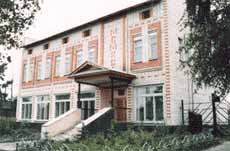 Sberbank.
Sberbank.
On the left side of the street there is the Sberbank. It was opened on
the 27th of March in 1992. Telmana str. (former Novoslobodskaya) faces
the square that was called Schepnaya. There was a market at that square.
There is a Calculating Centre built in 1989.Opposite the square there is a
silent green street called Lunacharskogo (former Nickolskaya str.). In the end
of the street there is the building that belonged to Arefyev, a merchant. There was a stable near the house.
After the Revolution a cinema was
situated there. There the inhabitants of Semyonov saw a colored film for the
first time.

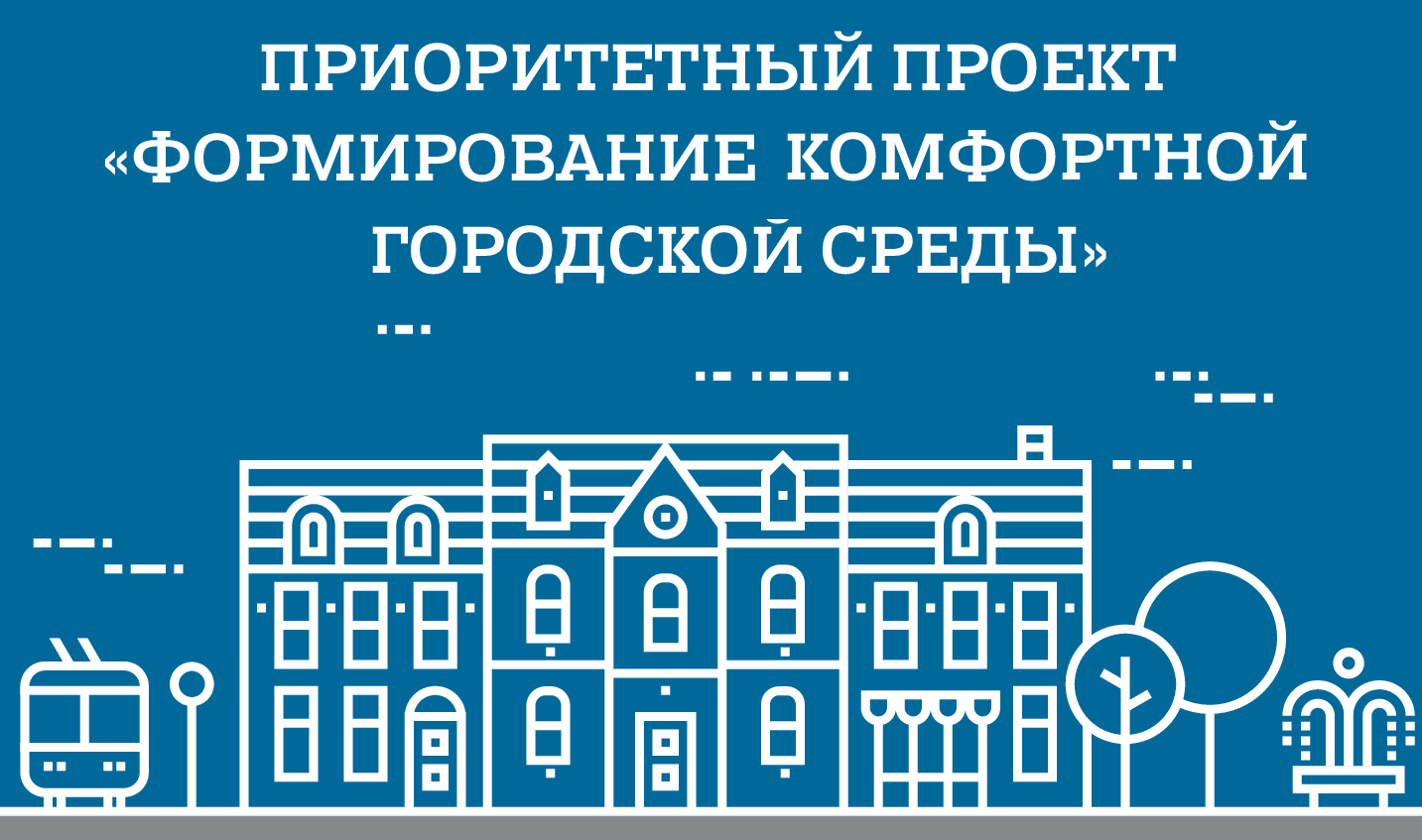

 ВЕРСИЯ ДЛЯ СЛАБОВИДЯЩИХ
ВЕРСИЯ ДЛЯ СЛАБОВИДЯЩИХ






 ВЕРСИЯ ДЛЯ СЛАБОВИДЯЩИХ
ВЕРСИЯ ДЛЯ СЛАБОВИДЯЩИХ


